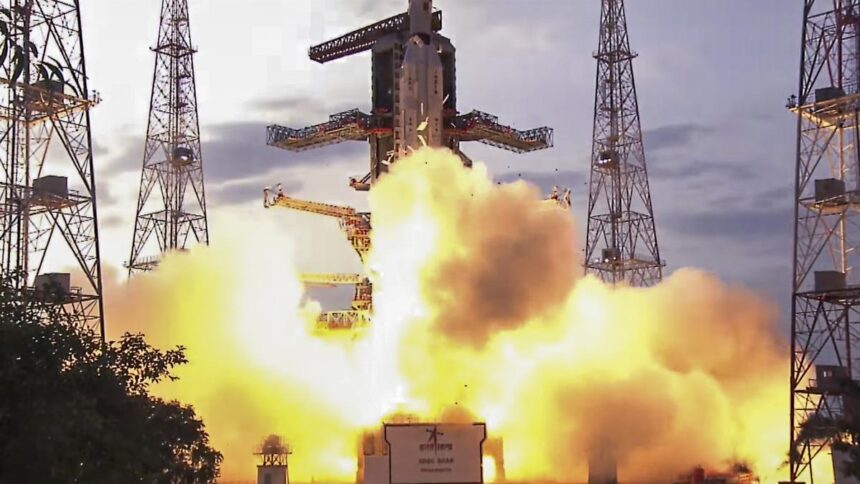NISAR Mission Launch Live: NASA-ISRO Earth Observation Satellite Takes Off from Sriharikota on July 30
A New Dawn in Indo-US Space Collaboration
On July 30, 2025, India and the United States scripted history in the skies above Earth, marking a significant milestone in international space cooperation. The successful launch of the NASA-ISRO Synthetic Aperture Radar (NISAR) satellite aboard India’s Geosynchronous Satellite Launch Vehicle (GSLV) F-16 rocket from Sriharikota marked the maiden joint space mission between the two nations. This is not merely a scientific event, but a strategic milestone symbolizing a new era in global partnerships, technological advancements, and collaborative exploration of Earth’s systems.
The GSLV F-16 lifted off with clinical precision, carrying its prestigious payload to an altitude of approximately 745 kilometers, injecting the NISAR satellite into a Sun Synchronous Polar Orbit (SSPO) just 19 minutes after launch. This flawless deployment represents not just the culmination of years of collaboration between NASA and ISRO but the beginning of an ambitious scientific agenda that could reshape how humanity understands its home planet.
What is NISAR and Why It Matters
NISAR, short for NASA-ISRO Synthetic Aperture Radar, is the world’s first dual-frequency radar imaging satellite that uses both L-band and S-band radar frequencies to provide high-resolution Earth observation data. Developed jointly by NASA and ISRO, the satellite brings together the best of both nations’ technological expertise—NASA contributed the L-band synthetic aperture radar, high-rate data transmitter, GPS receiver, and a solid-state recorder, while ISRO developed the S-band radar, spacecraft bus, and launch vehicle.
NISAR’s mission is critical for many reasons. It will observe Earth in unprecedented detail, capturing changes in our planet’s surface, from the shifting of tectonic plates to the melting of glaciers and fluctuations in agricultural productivity. It can scan the planet’s surface every 12 days, providing scientists and decision-makers with timely and accurate information for managing natural disasters, monitoring environmental changes, and ensuring food and water security.
This satellite’s unique capability to collect all-weather, day-and-night imagery over land and ocean makes it a powerful tool for a wide range of applications—from disaster response to sustainable development planning. The data gathered by NISAR will be openly available to researchers and policymakers around the world, democratizing access to critical Earth observation information.
The Science of Synthetic Aperture Radar (SAR)
Synthetic Aperture Radar, or SAR, is a revolutionary remote sensing technology that enables the capturing of high-resolution images of Earth’s surface, regardless of weather conditions or lighting. This makes SAR an invaluable tool for consistent Earth observation, as it can scan through clouds, at night, and in stormy or foggy weather.
SAR operates by emitting microwave signals toward the Earth and recording the echoes that bounce back from the surface. Unlike optical sensors that rely on sunlight, SAR systems actively generate their own signal. This makes SAR immune to many of the limitations that traditional satellite imaging faces.
In the case of NISAR, the mission leverages both L-band and S-band SAR. Each of these bands penetrates the Earth’s surface and canopy to varying degrees, allowing scientists to observe both deep structural changes and surface-level phenomena. For example:
- L-band SAR can penetrate vegetation and soil, making it ideal for monitoring land subsidence, tectonic shifts, and forest biomass.
- S-band SAR provides finer detail and is useful for monitoring infrastructure, water bodies, and surface deformations.
By capturing repeat observations every 12 days, NISAR can track minute changes over time — whether it’s the slow drift of tectonic plates, the swelling of a floodplain, or the degradation of an ecosystem.
The integration of dual-frequency SAR technology into a single platform represents a scientific first, allowing unprecedented insights into Earth’s processes across a wide spectrum of applications.
Mission Objectives – Understanding Earth’s Dynamic Systems
At the heart of the NISAR mission is an ambitious scientific agenda: to unravel the dynamics of our planet with a level of clarity and consistency never achieved before. The satellite’s all-weather, day-and-night monitoring capabilities allow for a wide array of applications across scientific, humanitarian, and strategic domains.
1. Land and Ice Deformation: One of NISAR’s central goals is to monitor the movement and deformation of Earth’s surface. This includes detecting tectonic plate motions, earthquakes, landslides, and the melting and shifting of glaciers. Its radar eyes can pick up changes as small as a few millimeters, providing invaluable data for disaster preparedness and climate research.
2. Ecosystem Monitoring: The satellite is expected to become a critical tool in tracking forest biomass and agricultural productivity. By measuring how vegetation grows, changes, or dies off over time, NISAR supports efforts to combat deforestation, enhance food security, and manage ecosystems more sustainably.
3. Hydrology and Flood Response: NISAR’s regular coverage will aid in the management of water resources and improve flood forecasting. By measuring surface water extent, soil moisture, and ground movement, it can support emergency response operations and long-term water planning strategies.
4. Urban Infrastructure and Subsidence: With increasing urbanization and infrastructure development, NISAR can help monitor ground subsidence in cities and industrial regions, helping urban planners and engineers take corrective actions before damage occurs.
5. Oceanographic Studies: Although optimized for land observation, the satellite also contributes to ocean studies by tracking coastal erosion, wave patterns, and oil spills.
What makes NISAR revolutionary is not only the scale and frequency of its coverage but also the accessibility of its data. ISRO and NASA have pledged to make a significant portion of the data freely available to researchers, governments, and institutions around the world.
As climate change intensifies and the global population continues to rise, such high-resolution, wide-coverage data becomes indispensable. NISAR is designed to deliver that information — consistently, accurately, and for the long term.
Global Impact and Open Data – A Satellite for Humanity
NISAR’s value extends far beyond the technical boundaries of space science. Its mission is rooted in service to humanity — from supporting environmental conservation to saving lives in the wake of disasters. At the heart of this initiative lies a revolutionary approach to data access: open sharing.
1. Democratizing Earth Observation: In a rare move for a high-end space mission, ISRO and NASA have committed to making a large portion of NISAR’s data freely available. This open data policy allows scientists, students, disaster relief agencies, governments, and non-profits around the world to access and utilize the satellite’s insights.
From developing nations seeking tools to manage deforestation, to academic institutions using it for climate modeling, NISAR will empower a new generation of decision-makers with actionable information.
2. Enhancing Disaster Resilience: Rapid-response mechanisms based on NISAR data can transform how the world reacts to crises. By monitoring surface deformations before earthquakes or assessing the spread of floodwaters in real time, emergency services can better allocate resources and save lives. The satellite’s wide swath and repeat coverage every 12 days ensures near-continuous monitoring of vulnerable regions.
3. Supporting Sustainable Development Goals (SDGs): NISAR’s contributions align closely with several United Nations SDGs — including climate action, sustainable cities, zero hunger, and clean water. By providing accurate data on forest health, soil moisture, and land use, NISAR becomes a crucial partner in shaping more sustainable policies worldwide.
4. Fostering International Collaboration: Beyond India and the United States, the mission sets a benchmark in international collaboration. Its success could encourage more bilateral and multilateral missions focused on global priorities. Countries across Asia, Africa, and Latin America stand to benefit from the insights NISAR generates.
5. Educational and Capacity Building Opportunities: With its data open to the public, NISAR is expected to serve as an educational resource for universities and institutions globally. ISRO and NASA are also expected to release toolkits, APIs, and training modules to help users interpret and integrate NISAR data into local contexts.
In sum, NISAR is not merely a satellite in orbit — it is a bridge between nations, disciplines, and generations. As more data begins to flow and as use cases evolve, NISAR will likely become one of the most impactful Earth observation platforms ever launched.
Also Read : Disha Patani Slays in ₹25K Streetwear Look, Turns Mumbai Streets Into Her Runway — 7 Viral Pics You Must See








